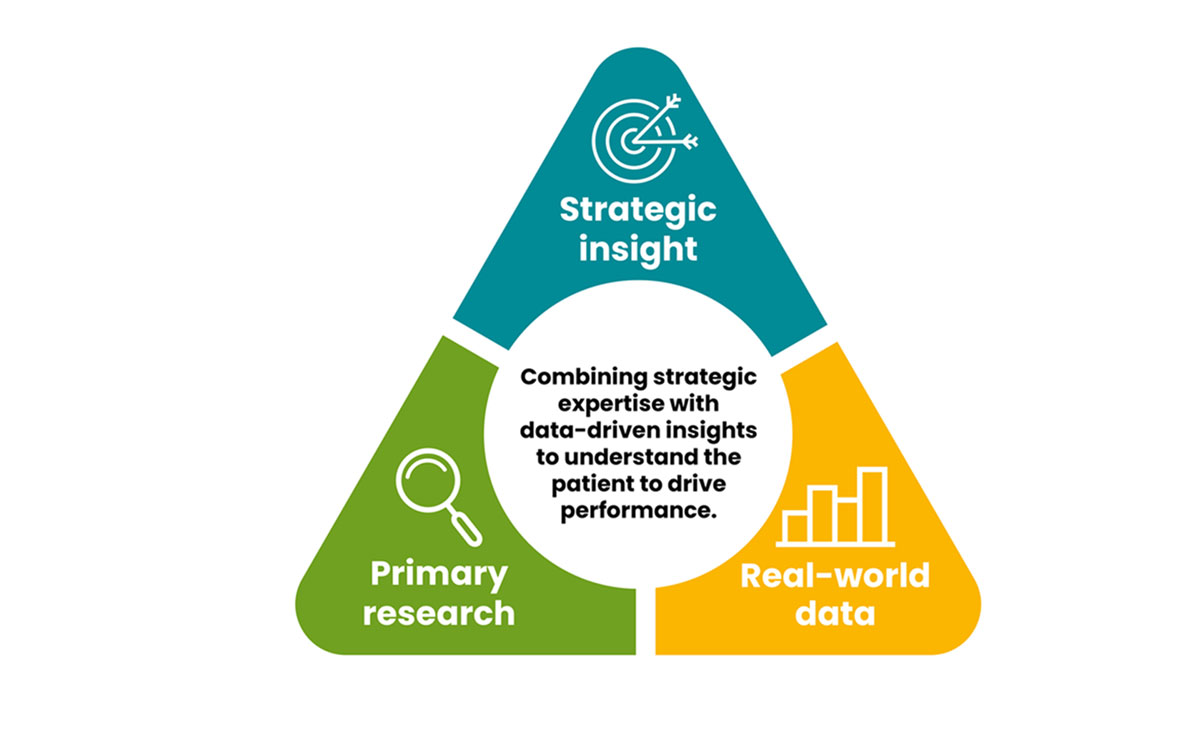Unique data insights offer world-class market understanding
At Putnam, we’re helping our clients drive brand performance across the product lifecycle, thanks to groundbreaking patient- and physician-level insights – all based on strategic analysis of market research and real-world data.
As the healthcare market evolves away from mass-market solutions towards more niche, personalized products, pharmaceutical companies face the complex challenge of finding specific patient populations to enhance brand performance.
Traditionally, pharma has relied on quantitative and qualitative primary market research such as demand assessments and ATUs (awareness, trial, and usage studies) to understand utilization, drivers, and barriers to use. But while these are important, the data they produce can be limited by sample size, stakeholder recall, and bias when it comes to honing in on the incredibly complex prescribing decisions made for individual patients. Brands, therefore, often find themselves making decisions on clinical development and marketing strategies with incomplete information of niche-opportunity patients or physicians.
Alternatively, many pharma companies are recognizing the value of ‘big data’ such as claims, electronic health records / lab, sales, and hospital data, in order to have broader and unbiased coverage of the market. However, these data sources are plagued by their own limitations in coverage, with each source varying in completeness, information capture, longitudinality, and update timing. More importantly, real-world data by their nature are not set up to directly answer many of the most important questions pharma clients are facing. Therefore, these data sets must be mined using carefully designed business rules developed by individuals with a deep understanding of the therapeutic area and market dynamics, as well as how situations are coded in the data set. With data alone, we have none of the stakeholders involved in the claim to provide explanation, context, or rationale.
A unique approach
At Putnam we’re solving this challenge in a unique way, creating bespoke projects that leverage and triangulate:
- Novel primary research methodologies
- Best-in-class advanced analytics and machine learning for AI-driven outputs, all from real-world data
- Strategic insight based on our deep understanding of therapeutic markets
This top-down (strategic-hypothesis-driven) and bottom-up (data-driven) approach creates an incredibly rich, detailed understanding of the market, designed to specifically answer clients’ key business questions.
Each project can use different data sources, and each of those sources differently. For example, in one project, initial learnings from descriptive analytics on patients receiving a therapy may be used to refine the patient profiles tested in market research. In another, demand drivers identified in a primary market research study can be linked back to claims for broader patient-level and prescribing HCP-level mapping.
Unrivaled detail
This approach offers a granular level of patient detail not seen before in the industry. It dives deep beyond the indication statement for a product and into patient characteristics driving treatment choice, such as demographics, socioeconomic background, level of fitness, and hundreds more variables. Together, these create rich, nuanced segmentations.
Of course, understanding who the right patients are is only one side of the coin. Putnam also uses this approach to identify physician characteristics, such as a particular approach to prescribing, treatment history, specialization and patient mix, knowledge, practice type and location, influences, and so on. It’s a fascinating web of detail not traditionally tapped into. By understanding the scenarios involving a certain type of patient with a certain type of physician, we can confidently develop current and future market maps – and that knowledge empowers our clients to optimize their strategies.
How does that work in practice? We had a client wanting to explore the opportunity for a new formulation of a therapy. They had a hypothesis of who the target patients were. But the initial descriptive analytics of currently treated patients revealed that the patient factor thought to be important was only a small part of the story. Additional qualitative patient journey and customer experience research supported the finding that several factors – many specific to the physician-prescriber rather than the patients themselves – were critical to the treatment decision. Using machine-learning models, we were able to interrogate hundreds of patient and physician variables to develop an AI-based prediction of a patient’s treatment choice. Through this work, our client had a crystal-clear view of the current and future opportunity, as well as who, how, and when to target customers to maximize that potential.
Bespoke insights
Another important aspect of this work is tailoring insights for each client stakeholder, as we recognize that each functional group within an organization has different needs and questions. In other words, beyond basic data outputs, we can shape the story differently depending on the team. While the marketing team might need to understand all the nuanced leverage points and challenges for each possible patient type to develop refined strategies, the field force may just require an understanding of core physician segments to target via the appropriate channel and messaging. Similarly, the clinical team will only need to discuss insights in scientific detail, but the executive board wants the big picture. Regardless of the client need, we’ve developed the right approach and applied the strategic thinking behind the scenes to address each stakeholder’s questions clearly and accurately.
This unique offering from Putnam is giving clients a world-class understanding of their market. Thanks to custom-designed approaches to data gathering and analysis – underpinned by therapeutic area, market, and client-level expertise – we’re helping pharma companies gain true strategic insight into patients and physicians, powering their clinical development plans and supporting them in shaping the market.
To find out more about how Putnam can give you an unrivaled understanding of the market to support brand performance, get in touch.

Jump to a slide with the slide dots.
 Mike Harvey
Mike Harvey
Insights from digital trends at ASH 2024 using ClarityNav, a proprietary AI-driven platform
Introduction The 2024 American Society of Hematology (ASH) Annual Meeting presented a wealth of data, unveiling the...
Read more Mohan Chukkapalli
Mohan Chukkapalli
Sunny side up – Biotech funding – 2025 & Beyond
Putnam shares key questions to consider in preparation of advancing trials and deals that have been put on hold.
Read more Scott Briggs
Scott Briggs
Medicare price negotiation: Putnam’s round two picks
Putnam predicts the 15 drugs likely to be selected for the second round of Medicare Price Negotiations.
Read more